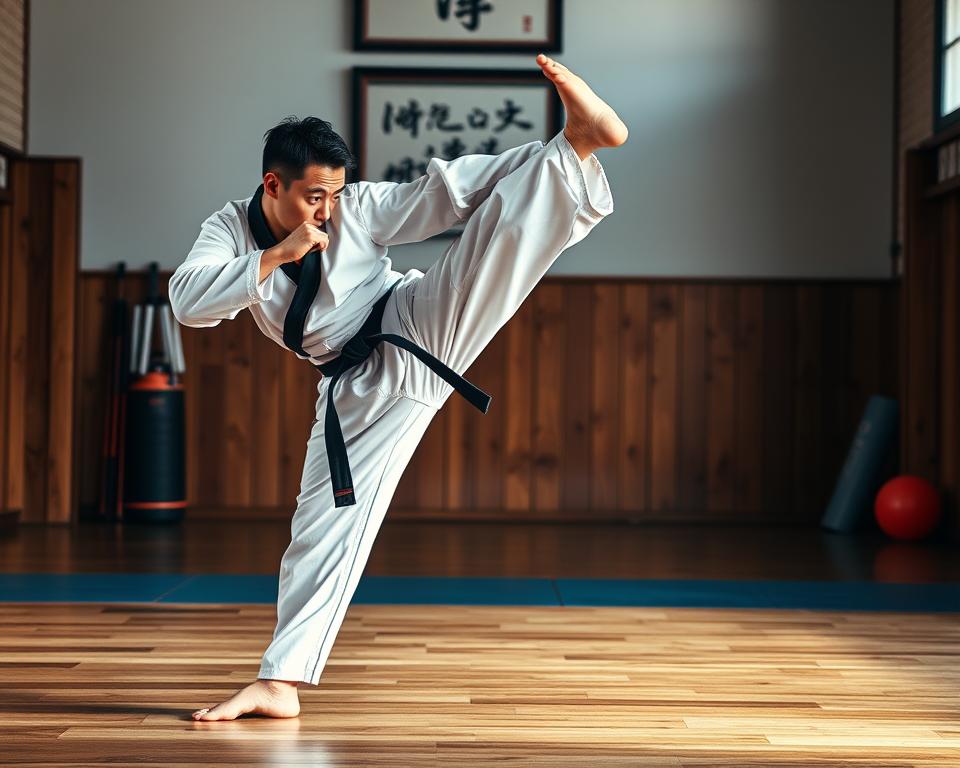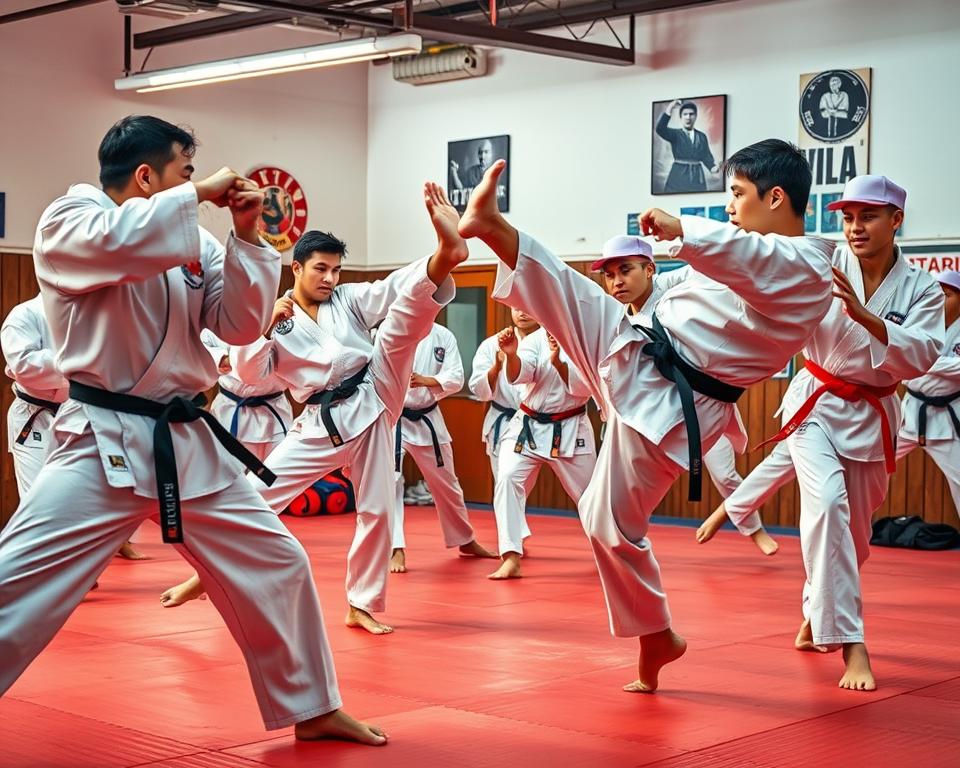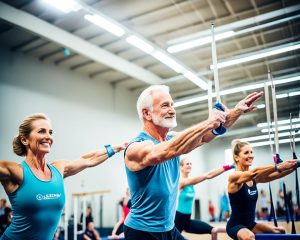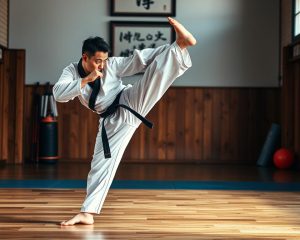
Get ready for an exciting journey into the world of Taekwondo Karate. This sport combines physical strength, mental focus, and Korea’s rich culture. You’ll learn about its history, benefits, and key techniques. This guide will help you master both training and self-defense skills.
Taekwondo Karate comes from ancient Korean martial arts and has become a worldwide favorite. It’s known for its fast moves, powerful kicks, and focus on honor, respect, and personal growth. This guide is for everyone, from beginners to experts, offering a deep dive into martial arts excellence.
Read interesting things at : luoghievisioni
Key Takeaways
- Discover the rich history and cultural significance of Taekwondo Karate
- Explore the physical, mental, and spiritual benefits of practicing this dynamic martial art
- Master the fundamental techniques, including stances, strikes, and high-powered kicks
- Understand the blend of tradition and modernity in Taekwondo Karate
- Learn effective self-defense strategies and the importance of situational awareness
Introduction to Taekwondo Karate
Taekwondo Karate is a famous Korean martial art loved by people all over the world. It has a long history and deep cultural roots that go back to ancient Korean times. It started as a way to defend oneself and has grown into a full system for improving the body, mind, and spirit.
History and Origins
The story of Taekwondo Karate begins in the Three Kingdoms period of ancient Korea. Back then, warriors and scholars used various martial arts and combat styles. Over time, these styles were made better and combined, leading to Taekwondo Karate. Important people like General Choi Hong Hi and Master Hwang Kee helped make this martial art what it is today and spread it around the world.
Benefits of Practicing Taekwondo Karate
Taekwondo Karate has many benefits for those who practice it. It helps build strength, flexibility, and quickness. It also helps with mental focus, self-control, and discipline. This martial art is great for improving your health, learning how to defend yourself, and growing mentally.
- Improved physical fitness and coordination
- Enhanced self-defense skills and situational awareness
- Increased mental focus, discipline, and stress management
- Deeper understanding of Korean culture and martial arts heritage
Whether you want to get better at self-defense, stay fit, or grow personally, Taekwondo Karate is a great choice. It’s rewarding for people of all ages and skill levels.
Fundamentals of Taekwondo Karate
Taekwondo Karate is built on a strong base of techniques and principles. It includes graceful stances for balance and powerful strikes and kicks for combat skills. This martial art aims to give practitioners the skills for self-defense and personal growth.
Stances and Footwork
Having a strong stance is key in Taekwondo Karate. Practitioners learn stances like Juchum Seogi, Ap Seogi, and Beom Seogi. These stances help in performing techniques with precision. Footwork patterns are also crucial, allowing for smooth movement in fights.
Basic Strikes and Kicks
Taekwondo Karate has a wide range of strikes and kicks. Techniques like Ap Chagi and Dollyo Chagi are powerful. Jireugi and Heru Chigi are precise and effective. Learning these techniques well is important for self-defense and winning in competitions.
| Taekwondo Karate Technique | Description |
|---|---|
| Ap Chagi | A powerful front kick delivered with the ball of the foot |
| Dollyo Chagi | A spinning hook kick executed with the instep or side of the foot |
| Jireugi | A basic punch strike using the first two knuckles of the fist |
| Heru Chigi | An elbow strike delivered with the sharp bony part of the elbow |
Learning the basics of Taekwondo Karate helps practitioners become skilled in self-defense and competitions. They develop the strength and combat skills needed to excel.
Taekwondo Karate: A Blend of Tradition and Modernity
The art of taekwondo karate combines ancient Korean martial arts with modern combat sports. It shows how Korean martial arts evolve, mixing old techniques with new methods. This mix creates a unique dance between tradition and modernity.
Taekwondo karate respects its deep history and culture. It keeps its core values while adapting to modern needs. This balance between tradition and innovation makes taekwondo karate stand out.
It moves from traditional forms to modern competition techniques smoothly. Taekwondo karate keeps its old teachings but also accepts new training methods and strategies. This mix keeps the art fresh and exciting for everyone.
This blend of tradition and modernity makes taekwondo karate captivating. It attracts both new and experienced practitioners.
“The true essence of taekwondo karate lies in its ability to seamlessly blend the timeless wisdom of the past with the innovative spirit of the present.”
Mastering the Art of Self-Defense
Taekwondo Karate is more than a martial art; it’s a powerful tool for self-defense. It teaches combat skills and techniques from ancient Korean traditions. This helps practitioners know how to react to threats and stay safe in different situations.
Situational Awareness
Being aware of your surroundings is key to self-defense. Taekwondo Karate training helps you see and understand what’s happening around you. It teaches you to spot risks, avoid trouble, and make smart choices.
Students learn to watch their environment closely. They can read people’s body language and trust their gut feelings to steer clear of danger.
De-escalation Techniques
Knowing how to handle tense situations without fighting is a big part of self-defense. Taekwondo Karate teaches you how to talk your way out of trouble. You’ll learn about body language, how to speak, and ways to solve conflicts peacefully.
- Maintaining calm and composed body language
- Using a respectful and non-confrontational tone
- Employing active listening and empathy to understand the other party
- Suggesting alternatives or compromises to find a peaceful resolution
By combining awareness and talking your way out of trouble, you can defend yourself well. This approach focuses on stopping problems before they start, calming things down, and using physical moves only when you really have to.
The Mind-Body Connection in Martial Arts
Taekwondo Karate is more than just kicking and punching. It’s a deep mix of physical and mental training. This ancient martial art goes beyond the physical to touch the mind and spirit.
The core of Taekwondo Karate is the mind-body connection. Mastering moves requires mental discipline, focus, and self-awareness. Training the body helps practitioners understand their minds and emotions better, linking physical and mental states.
“In Taekwondo Karate, the mind is the master, and the body is the servant. When the two work in harmony, true mastery is achieved.”
Training in Taekwondo Karate builds self-awareness. Students learn to stay focused, control their emotions, and act with precision. This mental strength helps them face life’s challenges with more resilience and calm.
Taekwondo Karate combines physical and mental training for a deep transformation. It’s a path of self-discovery. Mastering the body leads to mastering the mind, creating a balance that brings personal growth and peace.
| Benefits of the Mind-Body Connection in Taekwondo Karate | Outcomes |
|---|---|
| Increased Focus and Concentration | Improved performance and decision-making |
| Enhanced Emotional Regulation | Better stress management and conflict resolution |
| Cultivated Mental Resilience | Ability to overcome challenges and setbacks |
| Deeper Self-Awareness | Improved understanding of one’s strengths and weaknesses |
Training Regimens for Taekwondo Karate
To master Taekwondo Karate, you need a strong training plan. It should cover both your body and mind. You’ll need to work on strength, conditioning, flexibility, and mobility to do well in this martial art.
Strength and Conditioning Exercises
Adding strength training to your routine is key for powerful moves in Taekwondo Karate. Squats, lunges, and deadlifts work your lower body. Pull-ups, push-ups, and shoulder presses focus on your upper body. Then, there are plyometric exercises like box jumps and burpees that boost your explosive power and speed.
Flexibility and Mobility Drills
Taekwondo Karate needs you to be flexible and mobile, especially in your hips, ankles, and shoulders. Doing stretches and mobility drills regularly can help. This makes your movements smoother, lowers injury risk, and helps you perform better. Make sure to include dynamic stretches, static stretches, and exercises for joint mobility in your routine.
| Exercise Type | Benefits | Example Exercises |
|---|---|---|
| Strength Training | Builds muscular power and endurance | Squats, Lunges, Deadlifts, Pull-ups, Push-ups |
| Conditioning | Improves cardiovascular fitness and agility | Plyometrics, High-Intensity Interval Training (HIIT) |
| Flexibility | Enhances range of motion and reduces injury risk | Dynamic Stretches, Static Stretches, Mobility Drills |

By focusing on strength, conditioning, flexibility, and mobility, you can reach your best in Taekwondo Karate. This balanced approach will help you shine in the dojang and beyond.
Taekwondo Karate Forms (Poomsae)
Taekwondo Karate forms, known as Poomsae, are key to this martial art. They show off the deep traditional techniques and martial arts discipline of Taekwondo Karate.
Understanding the Significance of Forms
Poomsae are more than just exercises in Taekwondo Karate. They highlight the art’s history and philosophy. Each form is a set of taekwondo karate moves meant to improve understanding of forms and poomsae.
- Poomsae help keep the traditional techniques of Taekwondo Karate alive.
- They improve muscle memory, balance, and precision in taekwondo karate moves.
- Mastering Poomsae shows a practitioner’s hard work and commitment to martial arts discipline.
Learning about Taekwondo Karate forms helps practitioners value the art’s heritage. It shows how it’s still important today in the world of taekwondo karate.
“The forms of Taekwondo Karate are not mere exercises, but a physical embodiment of the art’s philosophy and history.”
Getting good at Poomsae is a big part of a taekwondo karate practitioner’s path. These detailed moves connect the past and present. They make sure Taekwondo Karate keeps growing and changing.
Competitive Aspects of Taekwondo Karate
Taekwondo Karate is more than just personal growth and self-defense. It has a competitive side that’s exciting. Athletes compete in tournaments, showing off their skills in techniques and strategies.
Competitions feature intense sparring, where athletes exchange quick strikes and kicks. The rules ensure safety and fairness. Athletes need great physical skills and mental strength to perform well under pressure.
| Tournament Type | Description | Key Techniques |
|---|---|---|
| Sparring | One-on-one matches where competitors use a variety of strikes and kicks to score points. | Roundhouse kicks, spinning hook kicks, and rapid footwork. |
| Forms (Poomsae) | Choreographed sequences of Taekwondo movements performed individually or in teams. | Precise execution of traditional forms, showcasing power, speed, and grace. |
| Breaking | Demonstrations of powerful strikes that can break wooden boards or other targets. | Powerful, focused strikes delivered with perfect technique and timing. |
To compete in Taekwondo Karate, you need a lot of training, discipline, and knowledge. You must improve your physical skills, think strategically, and build mental toughness. The excitement of the match and the support from others make these competitions thrilling for everyone.
Discipline and Respect in the Dojang
The Taekwondo Karate dojang is more than a place for physical training. It’s a sacred space that requires discipline and respect. The traditions and etiquette here create a united and peaceful training area.
Etiquette and Traditions
When you enter the dojang, you bow to show respect for the space and the art’s history. This act sets the tone for the session, bringing humility and focus. Students must follow a strict code, using honorifics for instructors and seniors, keeping good posture, and avoiding disruptions.
Respecting the hierarchy is key in Taekwondo Karate. Students must listen to their instructors and seniors, knowing that learning takes patience and discipline. This respect builds unity and friendship in the dojang.
| Taekwondo Karate Etiquette | Significance |
|---|---|
| Bowing upon entering and exiting the dojang | Showing respect for the training space and the art |
| Addressing instructors and seniors with honorifics | Acknowledging the hierarchy and experience within the martial arts discipline |
| Maintaining proper posture and attentiveness during training | Cultivating focus, discipline, and respect for the practice |
| Refraining from disruptive behavior | Creating a cohesive and harmonious training environment |
By following Taekwondo Karate’s etiquette and traditions, practitioners learn more about the martial arts. They also build a strong community and shared goals in the dojang.
Taekwondo Karate for Kids and Adults
Taekwondo karate is great for people of all ages, from kids to adults. It helps with discipline, fitness, and learning self-defense. This Korean martial art is perfect for everyone at different life stages.
Taekwondo Karate for Children
For kids, Taekwondo karate changes lives. It teaches important life skills and character. Kids learn how to strike, kick, and do forms in a safe way.
They also pick up values like respect, hard work, and self-control. This martial art boosts their confidence, focus, and sense of achievement. It prepares them for success in life.
Taekwondo Karate for Adults
Adults looking for a full fitness program and self-defense skills will love Taekwondo karate. It’s a mix of cardio, strength, and flexibility exercises. This keeps you fit in all areas.
It also teaches adults how to defend themselves safely. This means they can protect themselves and stay safe.
| Benefits for Children | Benefits for Adults |
|---|---|
|
|
Whether you’re a parent or an adult, Taekwondo karate is a great choice. It’s a powerful way to improve your life. You’ll learn important skills, reach your fitness goals, and grow in self-discipline and empowerment.
“Taekwondo karate is not just a sport, it’s a way of life that empowers individuals of all ages to reach their full potential.”
Integrating Taekwondo Karate into Daily Life
Taekwondo Karate is more than just a workout. It’s a lifestyle that helps you grow mentally and improve yourself. By using its principles in your daily life, you can boost your mental health and personal growth.
Mindfulness and Stress Management
Taekwondo Karate teaches mindfulness. Practicing forms and meditation helps you stay in the moment. This focus can help you deal with life’s stresses better.
Try adding a short Taekwondo Karate meditation to your day. It can help you feel calm and focused. Use mindfulness in everyday activities like eating or walking to stay calm.
Use what you learn from Taekwondo Karate to handle stress better. Make smart choices and act with clarity and grace.
Adding Taekwondo Karate to your life can bring many benefits. It helps you become more aware of yourself, resilient, and mentally healthy.
“The ultimate aim of Taekwondo Karate lies not in victory or defeat, but in the perfection of the character of its participants.” – Choi Hong Hi, Founder of Taekwondo
Choosing the Right Taekwondo Karate School
Finding the right taekwondo karate school or dojang is key to starting your martial arts journey. The school’s training environment, instructor qualifications, and culture affect your learning and skill growth.
Key Factors to Consider
- Instructor Credentials: Choose taekwondo karate schools with skilled and qualified teachers. Check their training, certifications, and teaching styles to make sure they can teach you well.
- Training Facilities: Look at the training environment of the martial arts school. Make sure the place is clean, safe, and has the right equipment and spaces for training.
- School Culture and Values: Notice the school’s atmosphere and values. See how students and teachers interact to understand the respect and teamwork there. This can affect your training and personal growth.
- Class Structure and Curriculum: Know the school’s class times, what they teach, and how they teach it. Make sure it fits your goals and how you like to learn, whether you want a traditional or modern taekwondo karate approach.
| Criteria | Importance | Considerations |
|---|---|---|
| Instructor Qualifications | High | Years of experience, certifications, teaching philosophy |
| Training Facilities | High | Cleanliness, safety, equipment, space |
| School Culture | High | Discipline, respect, camaraderie |
| Class Structure | Moderate | Curriculum, teaching methods, schedule |
Think about these factors to pick a taekwondo karate school that matches your goals, learning style, and what you like. This will help you have a great and changing martial arts experience.

Safety Precautions in Taekwondo Karate
Taekwondo karate is a martial art that needs a strong focus on safety. Students must look out for themselves and their training partners to avoid injuries. Following important safety rules helps students improve their skills safely and enjoy the art’s many benefits.
Protective Gear: The First Line of Defense
Wearing the right protective gear is key in taekwondo karate. Students should always use a mouth guard, groin protector, and gear for the head, hands, and feet. These items protect against injuries, letting students train and compete safely.
Responsible Training Protocols
Training in taekwondo karate must be done carefully. Instructors should teach proper techniques, slow skill building, and the need for warm-ups and cool-downs. Students should listen to their coaches and know their own limits to avoid injuries.
Vigilance and Situational Awareness
Being aware of your surroundings is very important in taekwondo karate. Students need to watch out for dangers and act quickly to avoid risks. This awareness not only keeps them safe but also helps them learn important self-defense skills.
By following these safety steps, taekwondo karate lovers can enjoy its many benefits without getting hurt. Staying safe makes this martial art a fulfilling and enriching experience for all students, no matter their age or skill level.
Conclusion
As we wrap up our exploration of Taekwondo Karate, it’s clear this martial art does more than just keep us fit. It changes us on many levels, from our bodies to our minds and spirits.
Taekwondo Karate goes beyond being a sport or a way to defend oneself. It’s a journey that pushes us to always get better, in skills and in life. It’s for everyone, from experts to beginners, offering a deep and fulfilling experience.
Learning Taekwondo Karate helps us grow in many ways. It builds mental discipline, increases self-awareness, and deepens our understanding of the mind-body connection. This makes Taekwondo Karate special, perfect for those looking for a lasting journey of lifelong learning.







